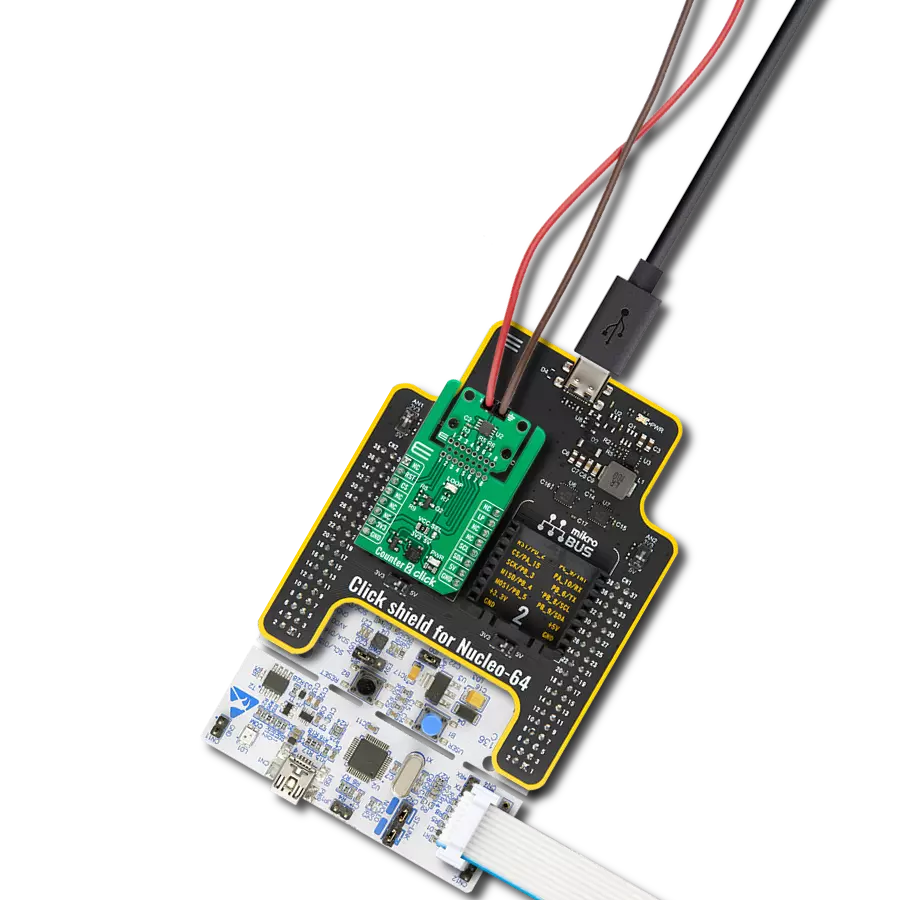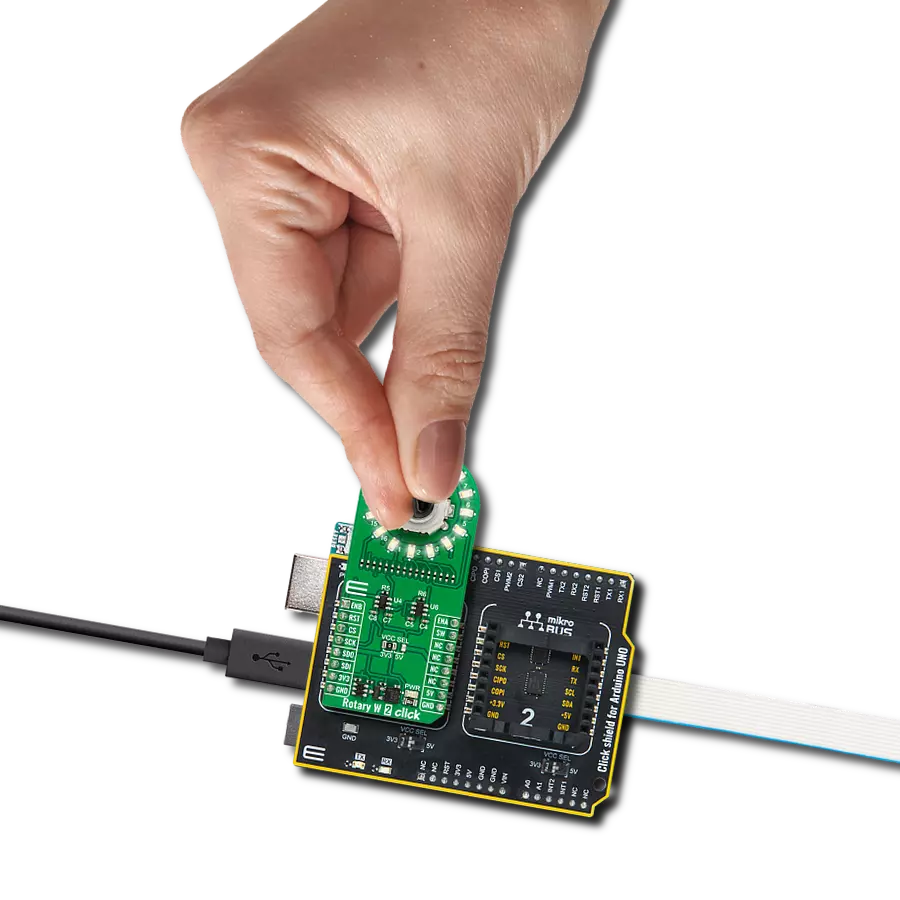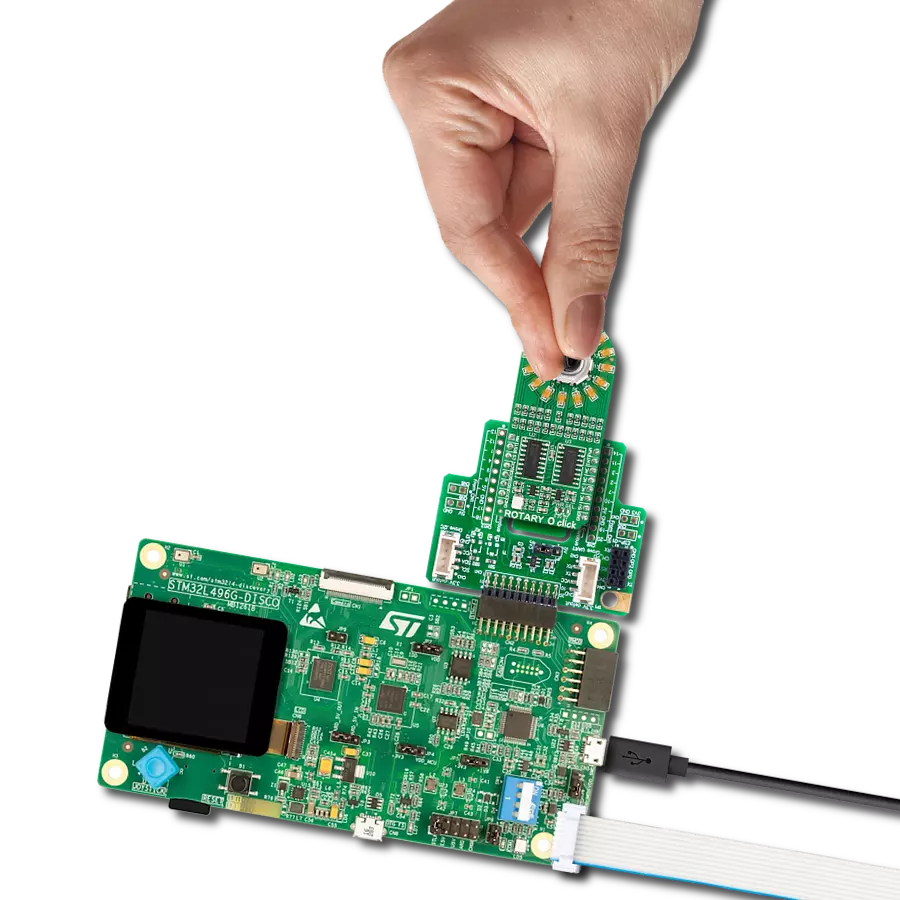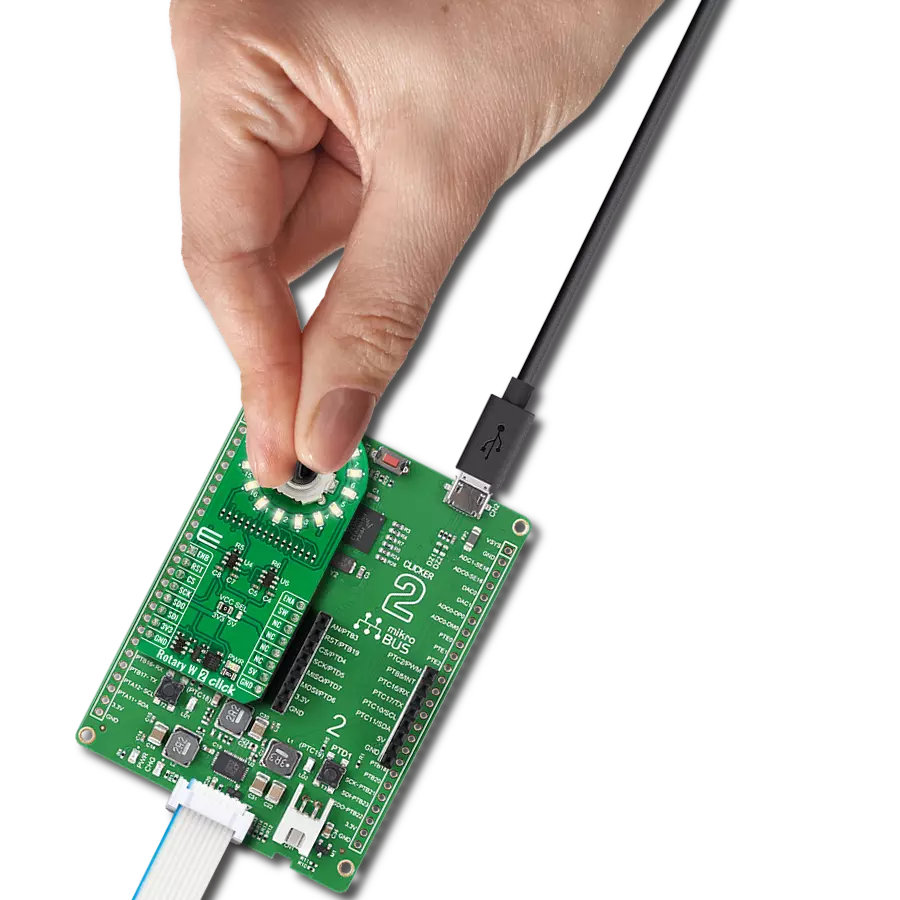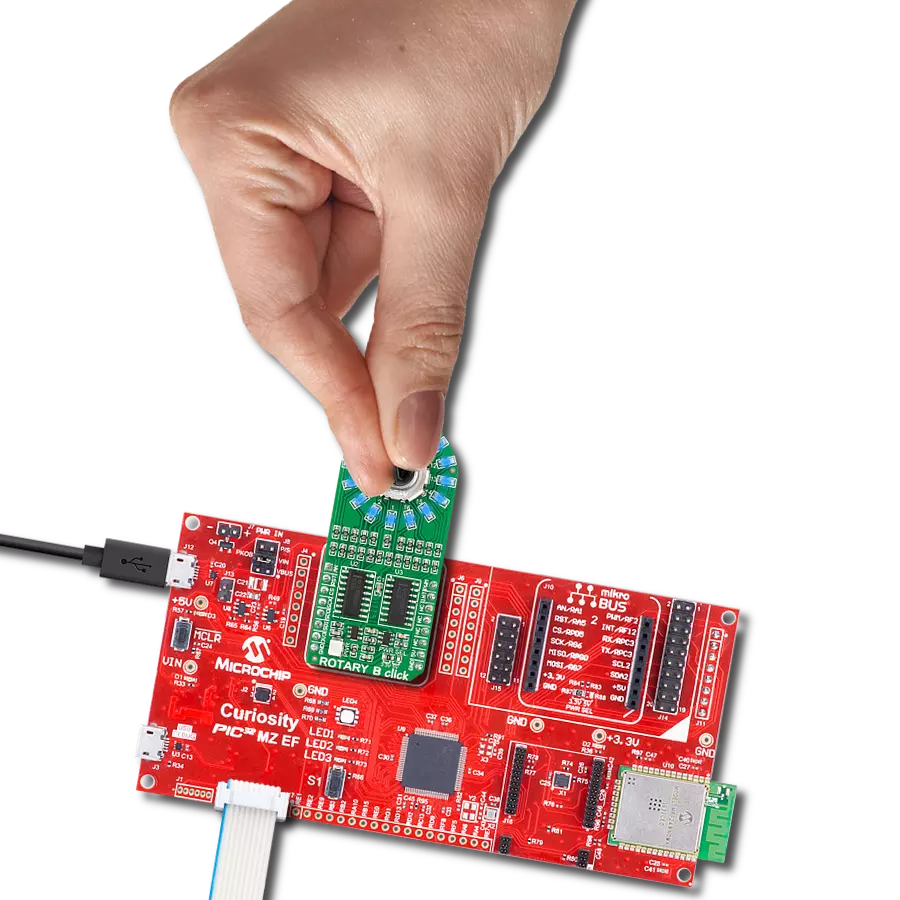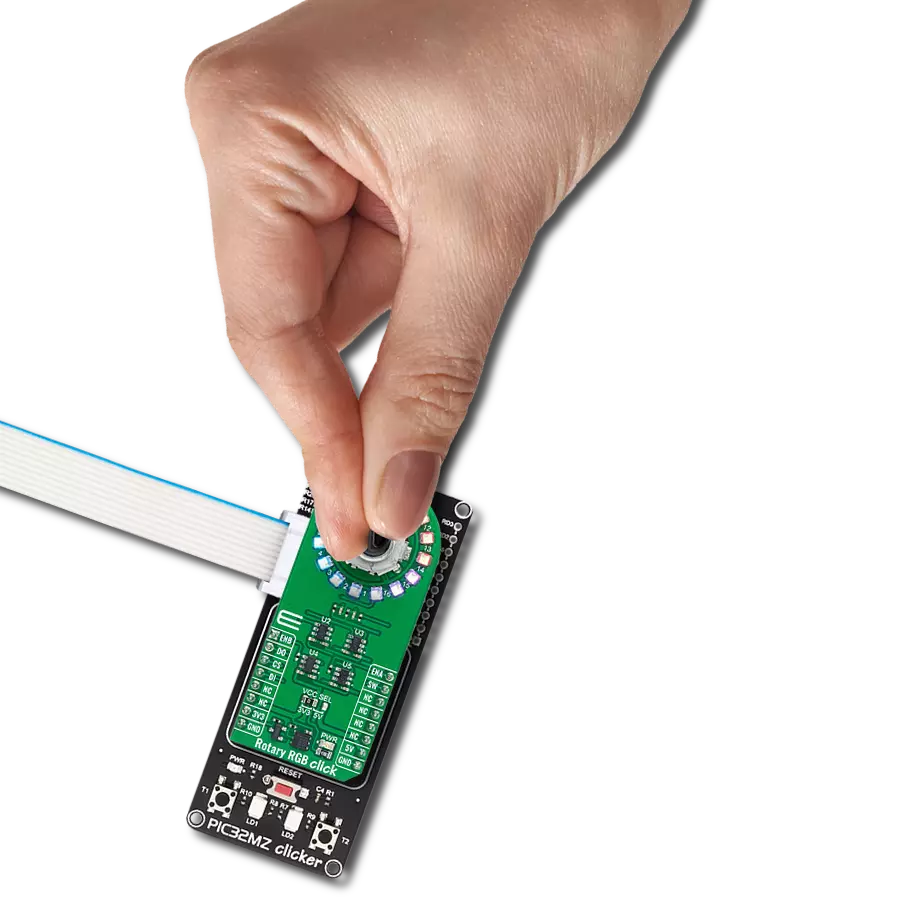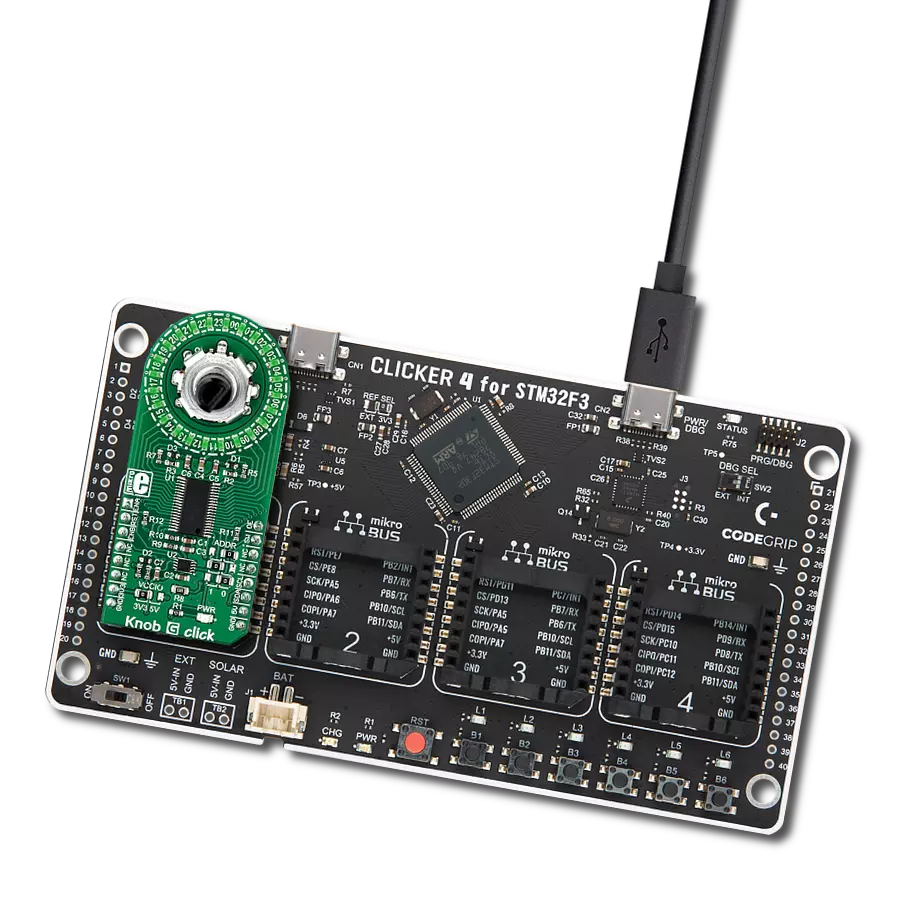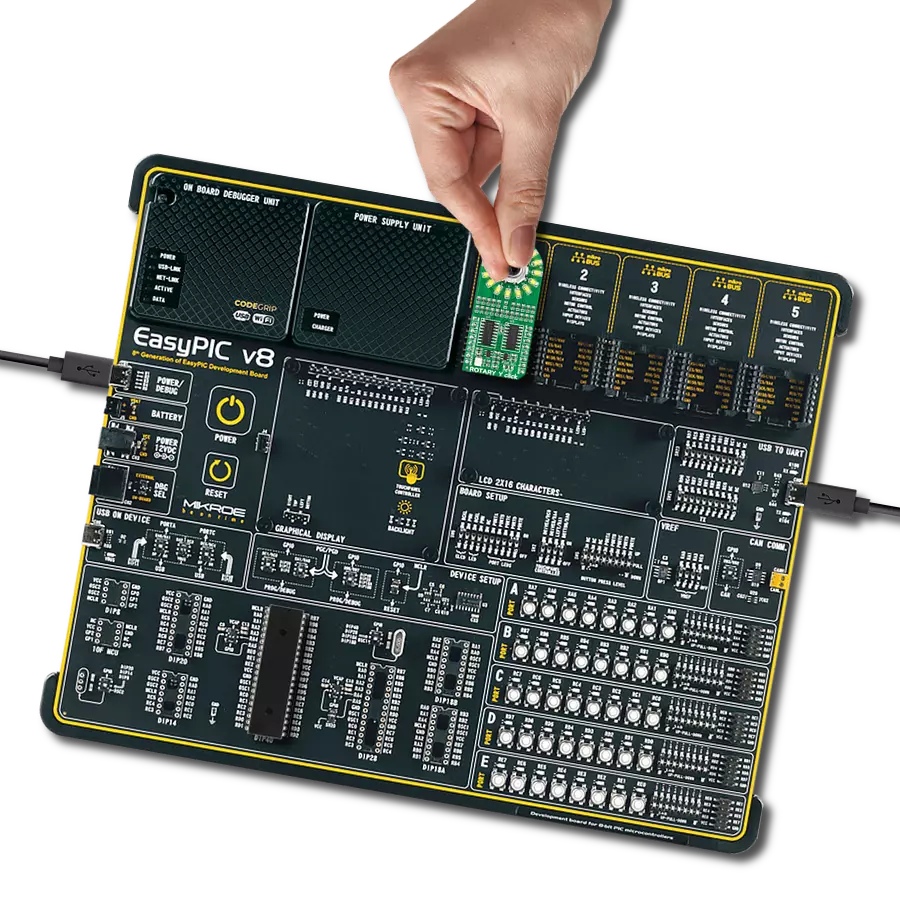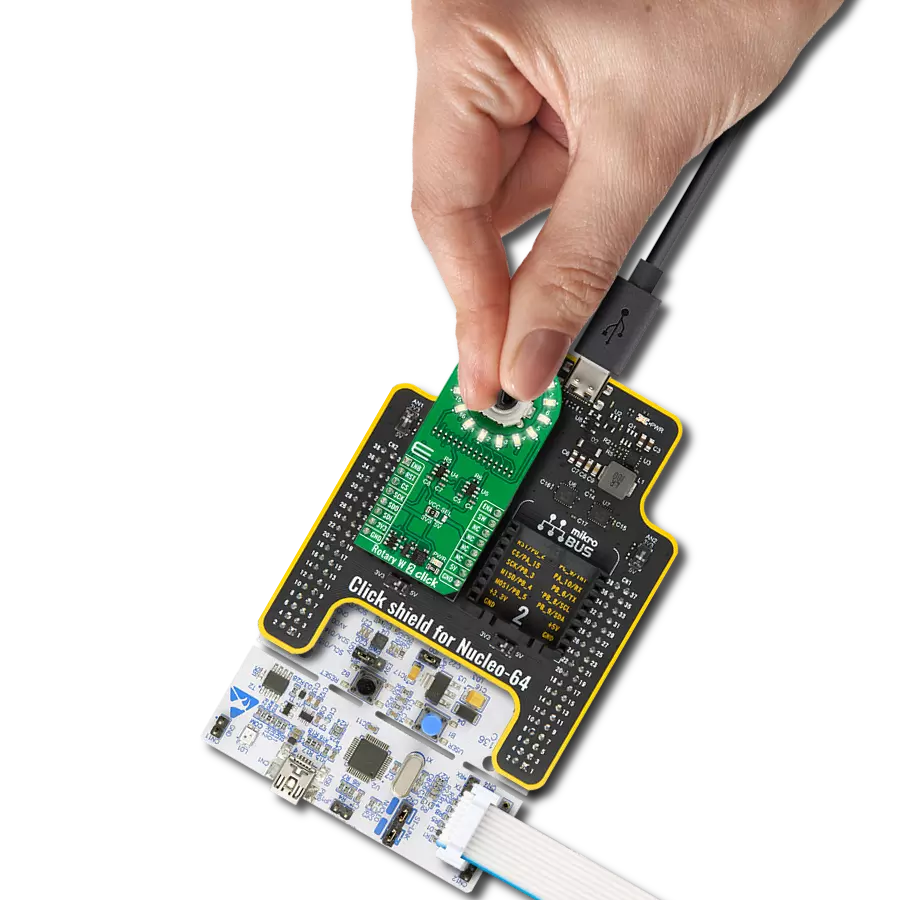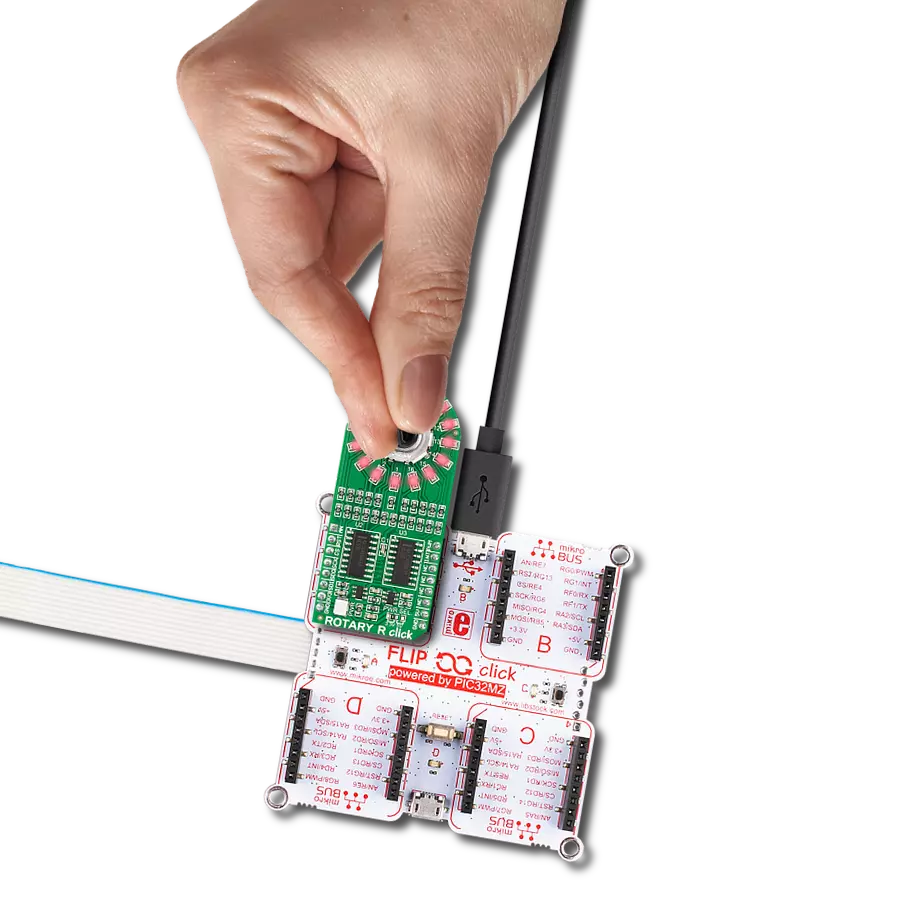Enhance electronic designs by providing a precision input knob with visual feedback through a ring of 16 white LEDs
A
A
Hardware Overview
How does it work?
Rotary W 2 Click is based on the TLC5925, a low-power 16-channel constant-current LED sink driver from Texas Instruments that, combined with a high-quality rotary encoder from ALPS, the EC12D1564402, allows you to add a precision input knob to your design. The EC12D1564402 incremental rotary encoder is surrounded by a ring of 16 green LEDs where a single rotation is divided into 15 discrete steps (in contrast to a potentiometer, a rotary encoder can be spun around continuously). The driver can control each LED individually, allowing various lighting effects to be programmed. The encoder outputs A and B signals (out of phase to each other) on the two mikroBUS™ lines, alongside the knob
push-button feature, which outputs through the interrupt line. The EC12D1564402 is a 15-pulse incremental rotary encoder with a push button. This encoder has unique mechanical specifications (debouncing time for its internal switches goes down to 2ms), and it can withstand a huge number of switching cycles, up to 30.000. The supporting debouncing circuitry allows contacts to settle before the output is triggered fully. Rotary W 2 Click uses a standard 4-wire SPI serial interface of the TLC5925 LED driver to communicate with the host MCU supporting clock frequency of up to 30MHz. Rotating the encoder, it outputs A and B signals (out of phase to each other) on the two mikroBUS™ lines,
ENA and ENB pins of the mikroBUS™ socket, alongside the push-button contact, which outputs through the SW pin (interrupt line) of the mikroBUS™ socket. Two SN74LVC1T45 single-bit dual-supply bus transceivers from Texas Instruments are used for logic-level translation. This Click board™ can operate with either 3.3V or 5V logic voltage levels selected via the VCC SEL jumper. This way, both 3.3V and 5V capable MCUs can use the communication lines properly. Also, this Click board™ comes equipped with a library containing easy-to-use functions and an example code that can be used as a reference for further development.
Features overview
Development board
EasyPIC v7 is the seventh generation of PIC development boards specially designed to develop embedded applications rapidly. It supports a wide range of 8-bit PIC microcontrollers from Microchip and has a broad set of unique functions, such as a powerful onboard mikroProg programmer and In-Circuit debugger over USB-B. The development board is well organized and designed so that the end-user has all the necessary elements in one place, such as switches, buttons, indicators, connectors, and others. With four different connectors for each port, EasyPIC v7 allows you to connect accessory boards, sensors, and custom electronics more efficiently than ever. Each part of
the EasyPIC v7 development board contains the components necessary for the most efficient operation of the same board. An integrated mikroProg, a fast USB 2.0 programmer with mikroICD hardware In-Circuit Debugger, offers many valuable programming/debugging options and seamless integration with the Mikroe software environment. Besides it also includes a clean and regulated power supply block for the development board. It can use various external power sources, including an external 12V power supply, 7-23V AC or 9-32V DC via DC connector/screw terminals, and a power source via the USB Type-B (USB-B) connector. Communication options such as
USB-UART and RS-232 are also included, alongside the well-established mikroBUS™ standard, three display options (7-segment, graphical, and character-based LCD), and several different DIP sockets. These sockets cover a wide range of 8-bit PIC MCUs, from PIC10F, PIC12F, PIC16F, PIC16Enh, PIC18F, PIC18FJ, and PIC18FK families. EasyPIC v7 is an integral part of the Mikroe ecosystem for rapid development. Natively supported by Mikroe software tools, it covers many aspects of prototyping and development thanks to a considerable number of different Click boards™ (over a thousand boards), the number of which is growing every day.
Microcontroller Overview
MCU Card / MCU
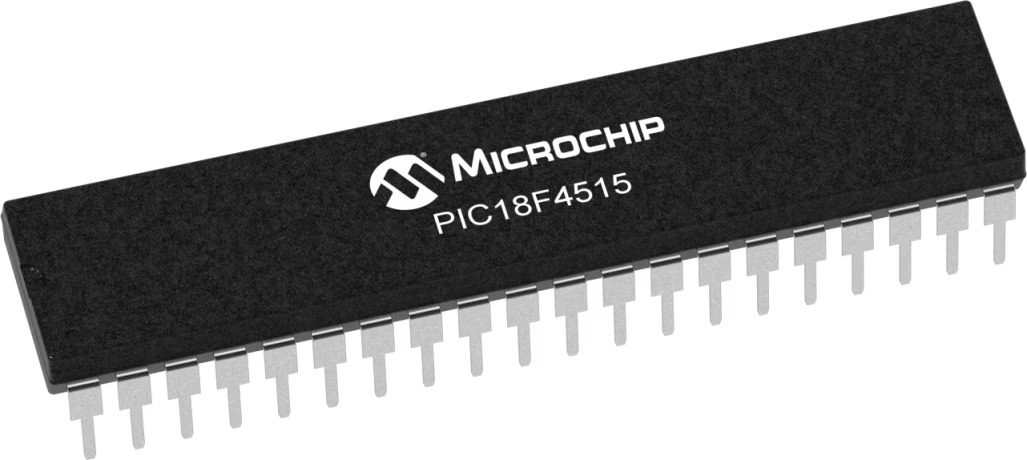
Architecture
PIC
MCU Memory (KB)
48
Silicon Vendor
Microchip
Pin count
40
RAM (Bytes)
3968
Used MCU Pins
mikroBUS™ mapper
Take a closer look
Click board™ Schematic
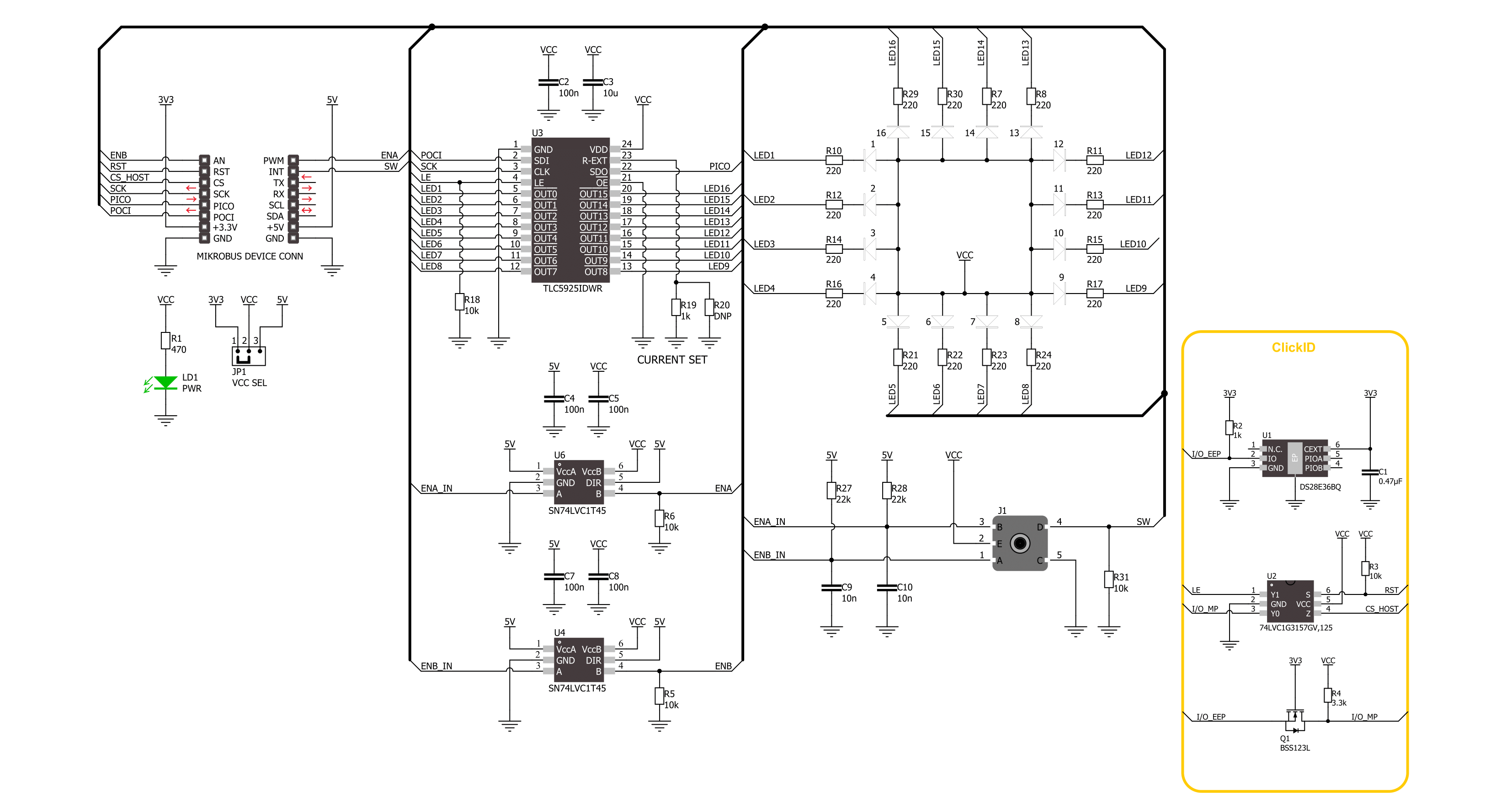
Step by step
Project assembly
Software Support
Library Description
This library contains API for Rotary W 2 Click driver.
Key functions:
rotaryw2_set_led_pos- Rotary W 2 set LED position function.rotaryw2_set_led_data- Rotary W 2 set LED data function.rotaryw2_get_state_switch- Rotary W 2 get switch state function.
Open Source
Code example
The complete application code and a ready-to-use project are available through the NECTO Studio Package Manager for direct installation in the NECTO Studio. The application code can also be found on the MIKROE GitHub account.
/*!
* @file main.c
* @brief Rotary W 2 Click example
*
* # Description
* This library contains the API for the Rotary W 2 Click driver
* to control LEDs states and a rotary encoder position readings.
*
* The demo application is composed of two sections :
*
* ## Application Init
* Initialization of SPI module and log UART.
* After the driver init, the app executes a default configuration and turn off all LEDs.
*
* ## Application Task
* This example demonstrates the use of the Rotary W 2 Click board™.
* The demo example shows the functionality of a rotary encoder used to control LEDs.
*
* @author Nenad Filipovic
*
*/
#include "board.h"
#include "log.h"
#include "rotaryw2.h"
#define ROTARYW2_ONE_LED ROTARYW2_SET_LED_DATA_1
#define ROTARYW2_TWO_LED ROTARYW2_SET_LED_DATA_1 | ROTARYW2_SET_LED_DATA_9
#define ROTARYW2_FOUR_LED ROTARYW2_SET_LED_DATA_1 | ROTARYW2_SET_LED_DATA_5 | \
ROTARYW2_SET_LED_DATA_9 | ROTARYW2_SET_LED_DATA_13
#define ROTARYW2_EIGHT_LED ROTARYW2_SET_LED_DATA_1 | ROTARYW2_SET_LED_DATA_3 | \
ROTARYW2_SET_LED_DATA_5 | ROTARYW2_SET_LED_DATA_7 | \
ROTARYW2_SET_LED_DATA_9 | ROTARYW2_SET_LED_DATA_11 | \
ROTARYW2_SET_LED_DATA_13 | ROTARYW2_SET_LED_DATA_15
#define ROTARYW2_EIGHT_LED_INV ROTARYW2_SET_LED_DATA_2 | ROTARYW2_SET_LED_DATA_4 | \
ROTARYW2_SET_LED_DATA_6 | ROTARYW2_SET_LED_DATA_8 | \
ROTARYW2_SET_LED_DATA_10 | ROTARYW2_SET_LED_DATA_12 | \
ROTARYW2_SET_LED_DATA_14 | ROTARYW2_SET_LED_DATA_16
static rotaryw2_t rotaryw2;
static log_t logger;
static uint8_t start_rot_status = 0;
static uint8_t led_demo_state = 0;
static uint8_t old_state = 0;
static uint8_t new_state = 1;
static uint8_t old_rot_state = 0;
static uint8_t new_rot_state = 1;
static uint16_t led_data = 1;
/**
* @brief Rotary W 2 select LED demo data function.
* @details This function selects one of the four LED demo data
* based on the current state of the LED demo.
* @return LED demo data:
* @li @c 0x0001 (ROTARYW2_ONE_LED) - Turn ON LED[1],
* @li @c 0x0101 (ROTARYW2_TWO_LED) - Turn ON LED[1,9],
* @li @c 0x0101 (ROTARYW2_FOUR_LED) - Turn ON LED[1,5,9,13],
* @li @c 0x5555 (ROTARYW2_EIGHT_LED) - Turn ON LED[1,3,5,7,9,11,13,15].
*/
static uint16_t rotaryw2_sel_led_demo_data ( uint8_t led_demo_state );
/**
* @brief Rotary W 2 switch detection function.
* @details This function is used for the switch state detection.
* @return Nothing.
*/
static void rotaryw2_switch_detection ( void );
/**
* @brief Rotary W 2 encoder mechanism function.
* @details This function is used to control the state of the LEDs
* by detecting the rotation direction of the rotary encoder.
* @return Nothing.
*/
static void rotaryw2_encoder_mechanism ( void );
void application_init ( void )
{
log_cfg_t log_cfg; /**< Logger config object. */
rotaryw2_cfg_t rotaryw2_cfg; /**< Click config object. */
/**
* Logger initialization.
* Default baud rate: 115200
* Default log level: LOG_LEVEL_DEBUG
* @note If USB_UART_RX and USB_UART_TX
* are defined as HAL_PIN_NC, you will
* need to define them manually for log to work.
* See @b LOG_MAP_USB_UART macro definition for detailed explanation.
*/
LOG_MAP_USB_UART( log_cfg );
log_init( &logger, &log_cfg );
log_info( &logger, " Application Init " );
// Click initialization.
rotaryw2_cfg_setup( &rotaryw2_cfg );
ROTARYW2_MAP_MIKROBUS( rotaryw2_cfg, MIKROBUS_1 );
if ( SPI_MASTER_ERROR == rotaryw2_init( &rotaryw2, &rotaryw2_cfg ) )
{
log_error( &logger, " Communication init." );
for ( ; ; );
}
if ( ROTARYW2_ERROR == rotaryw2_default_cfg ( &rotaryw2 ) )
{
log_error( &logger, " Default configuration." );
for ( ; ; );
}
log_info( &logger, " Application Task " );
}
void application_task ( void )
{
if ( ROTARYW2_OK == rotaryw2_set_led_data( &rotaryw2, led_data ) )
{
rotaryw2_switch_detection( );
rotaryw2_encoder_mechanism( );
}
}
int main ( void )
{
/* Do not remove this line or clock might not be set correctly. */
#ifdef PREINIT_SUPPORTED
preinit();
#endif
application_init( );
for ( ; ; )
{
application_task( );
}
return 0;
}
static uint16_t rotaryw2_sel_led_demo_data ( uint8_t led_demo_state )
{
switch ( led_demo_state )
{
case 0:
{
return ROTARYW2_ONE_LED;
break;
}
case 1:
{
return ROTARYW2_TWO_LED;
break;
}
case 2:
{
return ROTARYW2_FOUR_LED;
break;
}
case 3:
{
return ROTARYW2_EIGHT_LED;
break;
}
default:
{
return ROTARYW2_ONE_LED;
break;
}
}
}
static void rotaryw2_switch_detection ( void )
{
if ( rotaryw2_get_state_switch( &rotaryw2 ) )
{
new_state = 1;
if ( ( 1 == new_state ) && ( 0 == old_state ) )
{
old_state = 1;
led_demo_state = ( led_demo_state + 1 ) % 5;
if ( 4 == led_demo_state )
{
for ( uint8_t n_cnt = 0; n_cnt < 10; n_cnt++ )
{
rotaryw2_set_led_data( &rotaryw2, ROTARYW2_EIGHT_LED_INV );
Delay_ms ( 100 );
rotaryw2_set_led_data( &rotaryw2, ROTARYW2_EIGHT_LED );
Delay_ms ( 100 );
}
for ( uint8_t led_p = ROTARYW2_SET_LED_POS_1; led_p <= ROTARYW2_SET_LED_POS_16; led_p++ )
{
rotaryw2_set_led_pos( &rotaryw2, led_p );
Delay_ms ( 100 );
}
led_demo_state = 0;
led_data = rotaryw2_sel_led_demo_data( led_demo_state );
}
else
{
led_data = rotaryw2_sel_led_demo_data( led_demo_state );
}
}
}
else
{
old_state = 0;
}
}
static void rotaryw2_encoder_mechanism ( void )
{
if ( rotaryw2_get_state_ena( &rotaryw2 ) == rotaryw2_get_state_enb( &rotaryw2 ) )
{
old_rot_state = 0;
start_rot_status = rotaryw2_get_state_ena( &rotaryw2 ) && rotaryw2_get_state_enb( &rotaryw2 );
}
else
{
new_rot_state = 1;
if ( new_rot_state != old_rot_state )
{
old_rot_state = 1;
if ( start_rot_status != rotaryw2_get_state_ena( &rotaryw2 ) )
{
led_data = ( led_data << 1 ) | ( led_data >> 15 );
}
else
{
led_data = ( led_data >> 1 ) | ( led_data << 15 );
}
}
}
}
// ------------------------------------------------------------------------ END





















